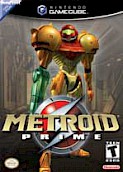Feature: History of Metroid
Posted 22 Mar 2003 by guest
It's hard to believe, but the last time we had a new Samus Aran adventure was way back in 1994. Since that Super Metroid game there have been rumours, speculation, and some more rumours about a possible return. Her fans had to remain patient though, as they wouldn't get their eager hands on new Metroid games until last year, with the release of Metroid Prime on the Gamecube and Metroid Fusion. Today, finally, we all get our hands on Metroid Prime, which promises to be an awesome experience. I mean, really, Metroid in 3D. God I can't wait. So now seems a good time to take a look back at the history of one of Nintendo's premier series, and undoubtedly, one of the most loved.
It all began a not-really-that long time ago, in a country just across the globe. August 1986 was the time. Japan was the country. Gunpei Yokoi was the man. Wait, scrap that, for 'man' simply won't do. Gunpei Yokoi was a genius, a true visionary, who helped shape the games industry just as much as the Miyamoto's and the Suzukis. Helmer of the Game Boy, he would release onto the unsuspecting public a new game that would spawn a successful and unforgettable series, as Mario and Zelda had been doing before it. The game? Metroid. Strange name really. What's a Metroid? Is he the main character? What's this all about?
And this being Nintendo, the game was far more than just a simple side-scrolling shooter. Many similar games were around during the 8-bit times, but Metroid dared to be different. Oh, how it dared. The basic, accepted layout of simple room layouts was throw out the window, Yokoi came up with sprawling room layouts that went up and down, and introduced an unheard incentive and reliance on upgrading your abilities and using these newfound abilities in exploring treaded ground to find previously unavailable secrets. The story was surprisingly mature for Nintendo, and was thoroughly engaging.
It went like this; the peaceful and happy galaxy was going along fine, but a threat emerged from a group of Space Pirates. They were using a race of creatures called 'Metroids', who are tough and resilient, and can gain energy and power from feeding off other creatures. These Metroids were from a planet called SR-388, and the Space Pirates were using them in their plan of galactic domination. After seeing off Mother Brain in the original game gamers everywhere were shocked to find that when Samus took off 'his' helmet, it was none other than a space maiden under it. And soon, that maiden would be in your pants...
Pants pocket that is, with Samus' handheld debut on the Game Boy. Gunpei Yokio's Metroid II: The Return of Samus saw the heroine being enlisted to yet again to help the galaxy. Although the game was limited to the 8-bit black-and-white green-hued machine, it featured the compelling gameplay of the original. New weapons and abilities were added to the mix, adding the joy of Metroid fans. The game delved more into the growth of the Metroids, and after defeating the bigger, badder Queen Metroid Samus saw one hatching with her own eyes. This last, final, Metroid clung to her like she was it's mother and Samus just couldn't bring herself to kill the little bugger. It seems the rock-hard bounty hunter had a little heart after all.
Samus returned the larva to the Galactic Federation for research, where the scientists of Cere Station discovered practical possibilities for the lifeform. It's ability to absorb energy could be very useful for industry and the like. The Metroids were gone, the Space Pirates were defeated, everything was back to normal. But such peace was short-lived, as while travelling through space Samus got a distress signal. Cere Station was under attack! Arriving at the station, Samus was horrified to find the scientists dead and the Metroid larva gone. While the Galactic Federation was going about their business, the Space Pirates didn't just sit about twiddling their thumbs, they were crawling back up from defeat, still bent on total domination. At the Research Station Samus confronts Ridley, a Space Pirate nemesis of old. Going off on her own, she follows Ridley back to Zebes, the Space Pirates' homeworld. To go to the core of evil, into the depths of hell, and to stare into the face of the devil himself. To finish the Space Pirates off once and for all.
Say hello to Super Metroid. Gamers certainly did, granting it an overwhelming positive response, triumphant air-punching all round. Many consider this game to be the peak of the series, and even the peak of gaming some say, a perfect cocktail of adventure, action, exploration, Kenji Yamamoto's classic score, artwork that oozed style, and compelling gameplay. Zebes, where the game is set, has been plundered, raped even, by the twisted Space Pirates, who have turned an idyllic, green planet into a horrible, black shadow of it's former self. Battling through the heart of the planet with a host of new abilities like the grapple beam and screw attack to play with. And in fitting irony, the end of the game saw that larva, all grown up, saving Samus' life in her battle against the Mother Brain. The weak Samus lets the Metroid see to Mother Brain. Finished with it, the Metroid channels it's energy into Samus to help her recover. But shock! The Mother Brain is not dead, and gets up, murdering the Metroid who's just finished with the energy rejuvenation process. Naturally enough, her blood boils and Samus beats that Mother Brain, escaping the planet to see it explode behind her. Samus, and the player, breathes a hugh sigh of relief. That's it. The Space Pirates are dead, gone, they'll never come back. But will they? Unfortunately, Nintendo fans had to wait an excruciating 8 years to find out.
When Prime first appeared, not everyone was so happy about the form it was in. Months went by with little to go on, there were rumblings of layoffs at Retro Studios, projects were cancelled, it seemed one of Nintendo's most treasured franchise wasn't in good hands. But we should've never worried, for the game appeared at last years E3 to an ecstatic audience, earning praise and superlatives by the bucketload. And along with it's little brother, Metroid Fusion, on the GBA, Metroid prime hit American shores on November 18th of last year. Nothing will be said of their plots for those who you who have yet to play the games, but all you need to know so far is Fusion continues the story after Super Metroid, while Metroid Prime fills us in on the goings-on on Tallon IV after the original Metroid and The Return of Samus on the Game Boy. Fusion has been out a while and certainly leaves up to the series' reputation, offering hours challenging, engrossing and thoroughly enjoyable gaming.
For many of us here at Cube-Europe, today is M-Day. One of the most anticipated titles of recent years hits shops shelves, and we will see whether it upholds the gaming crown the games has so gracefully earned. But, quite frankly, it will. And no doubt that one of the greatest series in gaming today will continue on, and on, even further than the recently-announced sequel to Metroid Prime. See you in five years for another 'History of Metroid' then!























